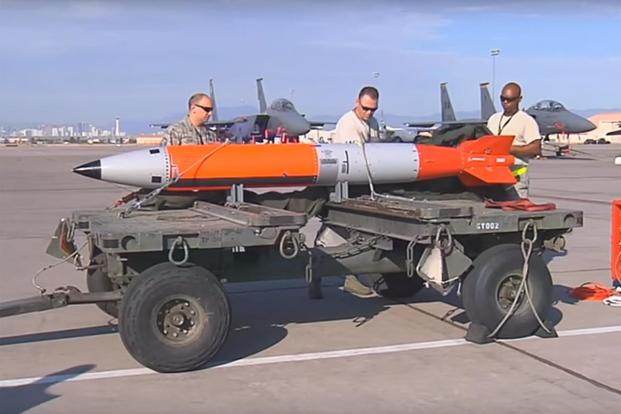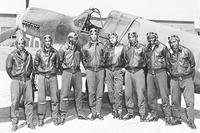The U.S. Air Force has conducted dozens of developmental flight tests of the B61-12 guided nuclear gravity bomb, intended to be three times more accurate than its predecessors, a top general said Tuesday.
"We've already conducted 26 engineering, development and guided flight tests," said Lt. Gen. Jack Weinstein, deputy chief of staff for strategic deterrence and nuclear integration. "The program's doing extremely well."
The B61-12 modification program, which has been in the works for at least seven years, is slated to be carried by the B-2 Spirit, as well as the future B-21 Long Range Strategic Bomber, known as the Raider.
Related content:
- F-35 Could Carry B61 Nuclear Warhead Sooner Than Planned
- Lawmaker: US Should Field New Nukes After Russia Violated Treaty
- Air Force Eyes Replacing B-52 Engines
Weinstein did not say which platforms have done the latest testing, but the F-35 Lightning II joint program office has been working on integrating the latest modification into its weapons arsenal. It is slated to be fielded sometime in the 2020s.
During his speech to an audience at an Air Force Association breakfast in Washington, D.C., Weinstein highlighted the progress the U.S. has been making in its nuclear force.
The Pentagon's recent Nuclear Posture Review not only calls for more low-yield nuclear weapons but emphasizes the "crucial" need to modernize current standing weapons, such as the air-launched cruise missile and intercontinental ballistic missiles, as part of the nuclear triad.
The triad consists of land-based intercontinental ballistic missiles (ICBMs), strategic bombers, and submarine-launched ballistic missiles (SLBMs).
Weinstein cited bombers such as the B-52 Stratofortress and B-2 Spirit, which are capable of launching both conventional or nuclear payloads, and also legacy fighters such as the F-16 Fighting Falcon and F-15E Strike Eagle.
"When I say 'dual-capable aircraft,' I need to be really specific," he said. "Dual-capable aircraft is called the B-52 and B-2 -- it does conventional and nuclear. It also means F-16s and Strike Eagles, and other aircraft our NATO partners fly."
The F-35 was designed with a requirement to carry a nuclear payload. In 2015, an F-35 flew with the B61-12 to measure its vibration in the aircraft's weapons bay.
Both of the fourth-gen fighters will be able to deploy the B61-12 bomb. The B61-12 also conducted its third and final developmental test flight aboard an F-15E in 2015.
Long Live the B-52
Weinstein added that re-engining the B-52 -- long on the Air Force's wish list, along with a new radar -- remains critical if the service intends to keep the venerable bomber flying into the 2050s.
The Air Force requested roughly $1.5 billion in its fiscal 2019 budget to kick-start the re-engining effort. The program is expected to cost roughly $7 billion to $8 billion over its lifetime.
"Every time you renovate a house, you don't realize there's asbestos behind the wall," Weinstein said, referring to problems that may develop as the service renovates the Cold War-era bomber.
"We've been talking about re-engining the B-52 for a long time," he said, adding that he's received reassurance from Dr. Will Roper, Air Force undersecretary for acquisitions, technology and logistics, that the re-engining program will continue with proper supervision.
"Am I going to sit here and say we're not going to have a problem with the re-engining? I'm not going to say that," Weinstein said. "I will tell you an awful lot of work has gone into evaluating how to re-engine, what is the best way to do it, why we [decided] not to do a [service] life extension program on [a] really old engine ... so the work that has been upfront. It's going to take ... constant oversight as we go through the process."
Overall, he added, nuclear modernization is well on its way to becoming more manageable and survivable -- as long as budgets remain consistent.
"I'd like to say I want [things] faster and cheaper," Weinstein said, referring not only to weapons currently in production such as the Long Range Standoff Weapon, but also communication and control systems.
He said current funding in the fiscal 2018 National Defense Authorization Act for the nuclear enterprise remains "healthy" for what the force needs.
"Overall, I'm really pleased with the support we're getting from the Hill," Weinstein said. "That budget, it was a pretty good-sized chunk" for nuclear weapons and systems.
"We'll see what happens with [other] budgets in the future," Weinstein added.
-- Oriana Pawlyk can be reached at oriana.pawlyk@military.com. Follow her on Twitter at @Oriana0214.









